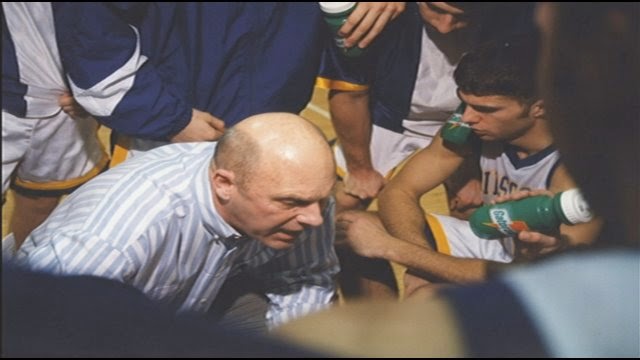Tough day a few days ago learning of the passing of Coach Bob Boyd who I had the privilege of working with for a year at LSU. Years before, Coach Dale Brown sent me to the West Coast to spend a couple of days with Coach John Wooden and then on to Coach Boyd's house where we spent a day out by his pool with me peppering him with questions and soaking in his knowledge. When I came back I told Coach Brown we had to get Coach Boyd to Baton Rouge for our fall Coaching Clinic which we did. Over the next few days, I will share some of my notes from Coach Boyd that I got from both his home and our fall clinic:
Bringing the
ball above the head is a common problem – not hard to guard.
Backline in
2-3 must understand where their overall territory is that they must cover.
On zone
offense, a wing must know who’s defending him and take the ball away from where
he came.
To cover the
ball in the zone, backline must be active. If you play zone defense, break it
down in drill form. Can work on both zone offense and zone defense in whole or
part method at the same time. Zone defenders must constantly be aware of
players in their area.
Time and score
would dictate his pressing.
Doesn’t like
gambling, all out denial unless behind late in the game (and must practice
those type of situations in practice.)
:30 to play
and behind by 3 or more we want to deny then foul – no more than 2 seconds be
ran off.
On inbounds
defense –
- Scouting is important
- Give an obvious show (be big, take
room, bump em)
- Team don’t practice enough and
when they do, they don’t do with game
like
intensity. (can’t run inbounds plays against Indiana)
Knight spent
the entire fall (2-hour, 3 man) practice period teaching screening. No one in
the nation screens better than Indiana yet Knight thinks they do it poorly.
What should that tell the rest of us about our screening.
Without
game-like intensity in practice you can’t be effective in a game. Game-like
intensity comes from coaching leadership.
Good defensive
players must be “suspicious” (constantly anticipating.) Mike Singletary of the
Chicago Bears. Stance-ready-suspicious. Important on inbounds defense
especially.
Kids know when
their parents are serious or not, caring or not, prepared or not, so you know
they can read coaches.
Your
basketball facility (floor, offices, locker room, etc.) is your classroom. Do
you have a “good learning environment.” Important to make kids “receptive” to learning.
Good teachers
don’t try to trick their students.
Bounce pass
(lead low) vs. retreating defender.
Talent
sometimes resents loss of identity that sometimes comes with motion offense.
Performance
must be a Projection of Practice.
The true test of
a coach is to coach effectively through resistance.
Ran flex with
Post Exchange (he called it “high-low passing game”.) Liked to split the low
post in motion with a screen.
When running
flex, used a variety of entries to disguise it.
Doesn’t want
symmetrical look in PE (1-3-1).
If he came
back to coach today he would
- Make it simpler
- Be emphatic about rebounding
Can’t change
performance until you change attitude.
Before the
3-point arc, he wanted his team to shoot 55% from the floor. He wanted his
identity to come from field goal shooting percentage.
If you run
motion, you need to stay away from junior college players and have four year
players in your program.
Important in
zone offense to “stretch” the defense with spacing and backside players. He
wanted to dunk against a zone. Bring the ball into the paint before an outside
shot. Must breakdown zone offense (perimeter & post). Likes loop to elbow
screen vs. zone defense. Rover against odd front zone. Must attack the backside
of zone defense.
Does not think
it is necessary to have more than one alignment of motion to be effective.
Regular or High Low. Likes possibilities of triangle.
Against
defense that switches, besides slipping, have your cutter make a tight curl
(will open up a screener that widens out on the perimeter. Must find “daylight”
before slip.












